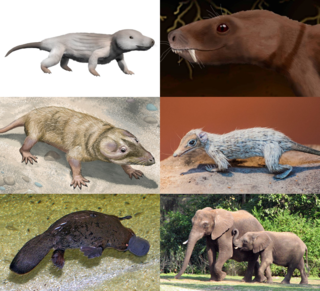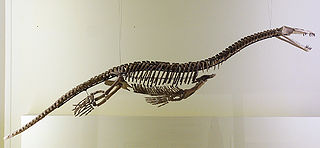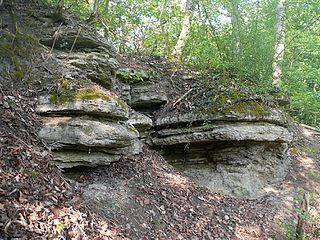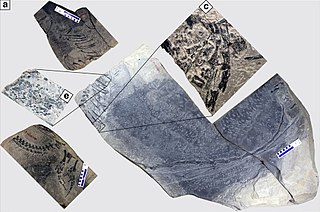The Mesozoic Era, also called the Age of Reptiles and the Age of Conifers, is the second-to-last era of Earth's geological history, lasting from about 252 to 66 million years ago, comprising the Triassic, Jurassic and Cretaceous Periods. It is characterized by the dominance of archosaurian reptiles, like the dinosaurs; an abundance of conifers and ferns; a hot greenhouse climate; and the tectonic break-up of Pangaea. The Mesozoic is the middle of the three eras since complex life evolved: the Paleozoic, the Mesozoic, and the Cenozoic.

The Permian–Triassicextinction event, also known as the Latest Permian extinction event, the End-Permian Extinction and colloquially as the Great Dying, formed the boundary between the Permian and Triassic geologic periods, as well as between the Paleozoic and Mesozoic eras, approximately 251.9 million years ago. It is the Earth's most severe known extinction event, with the extinction of 57% of biological families, 83% of genera, 81% of marine species and 70% of terrestrial vertebrate species. It was the largest known mass extinction of insects.
The Triassic is a geologic period and system which spans 50.6 million years from the end of the Permian Period 251.902 million years ago (Mya), to the beginning of the Jurassic Period 201.36 Mya. The Triassic is the first and shortest period of the Mesozoic Era. Both the start and end of the period are marked by major extinction events. The Triassic Period is subdivided into three epochs: Early Triassic, Middle Triassic and Late Triassic.

The Triassic–Jurassic (Tr-J) extinction event, often called the end-Triassic extinction, marks the boundary between the Triassic and Jurassic periods, 201.3 million years ago, and is one of the top five major extinction events of the Phanerozoic eon, profoundly affecting life on land and in the oceans. In the seas, the entire class of conodonts and 23–34% of marine genera disappeared. On land, all archosauromorphs other than crocodylomorphs, pterosaurs, and dinosaurs became extinct; some of the groups which died out were previously abundant, such as aetosaurs, phytosaurs, and rauisuchids. Some remaining non-mammalian therapsids and many of the large temnospondyl amphibians had become extinct prior to the Jurassic as well. However, there is still much uncertainty regarding a connection between the Tr-J boundary and terrestrial vertebrates, due to a lack of terrestrial fossils from the Rhaetian (latest) stage of the Triassic. What was left fairly untouched were plants, crocodylomorphs, dinosaurs, pterosaurs and mammals; this allowed the dinosaurs, pterosaurs, and crocodylomorphs to become the dominant land animals for the next 135 million years.

Therapsida is a major group of eupelycosaurian synapsids that includes mammals, their ancestors and relatives. Many of the traits today seen as unique to mammals had their origin within early therapsids, including limbs that were oriented more underneath the body, as opposed to the sprawling posture of many reptiles and salamanders.

The cynodonts are a clade of eutheriodont therapsids that first appeared in the Late Permian, and extensively diversified after the Permian–Triassic extinction event. Cynodonts had a wide variety of lifestyles, including carnivory and herbivory. Mammals are cynodonts, as are their extinct ancestors and close relatives, having evolved from advanced probainognathian cynodonts during the Late Triassic. All other cynodont lines went extinct, with the last known non-mammalian cynodont group, the Tritylodontidae, having its youngest records in the Early Cretaceous.

The Bibionomorpha are an infraorder of the suborder Nematocera. One of its constituent families, the Anisopodidae, is the presumed sister taxon to the entire suborder Brachycera. Several of the remaining families in the infraorder are former subfamilies of the Mycetophilidae, which has been recently subdivided. The family Axymyiidae has recently been removed from the Bibionomorpha to its own infraorder Axymyiomorpha.

Lepidosauromorpha is a group of reptiles comprising all diapsids closer to lizards than to archosaurs. The only living sub-group is the Lepidosauria, which contains two subdivisions, Squamata, which contains lizards and snakes, and Rhynchocephalia, the only extant species of which is the tuatara.

Lystrosaurus is an extinct genus of herbivorous dicynodont therapsids from the late Permian and Early Triassic epochs. It lived in what is now Antarctica, India, China, Mongolia, European Russia and South Africa. Four to six species are currently recognized, although from the 1930s to 1970s the number of species was thought to be much higher. They ranged in size from that of a small dog to 8 feet long.

Nothosaurus is an extinct genus of sauropterygian reptile from the Triassic period, approximately 240–210 million years ago, with fossils being distributed from North Africa and Europe to China. It is the best known member of the nothosaur order.

In the geologic timescale, the Anisian is the lower stage or earliest age of the Middle Triassic series or epoch and lasted from 247.2 million years ago until 242 million years ago. The Anisian Age succeeds the Olenekian Age and precedes the Ladinian Age.

Placodonts are an extinct order of marine reptiles that lived during the Triassic period, becoming extinct at the end of the period. They were part of Sauropterygia, the group that includes plesiosaurs. Placodonts were generally between 1 to 2 m in length, with some of the largest measuring 3 m (9.8 ft) long.

The Early Triassic is the first of three epochs of the Triassic Period of the geologic timescale. It spans the time between 251.902 Ma and 247.2 Ma. Rocks from this epoch are collectively known as the Lower Triassic Series, which is a unit in chronostratigraphy.

In the geologic timescale, the Middle Triassic is the second of three epochs of the Triassic period or the middle of three series in which the Triassic system is divided in chronostratigraphy. The Middle Triassic spans the time between 247.2 Ma and 237 Ma. It is preceded by the Early Triassic Epoch and followed by the Late Triassic Epoch. The Middle Triassic is divided into the Anisian and Ladinian ages or stages.
The Late Triassic is the third and final epoch of the Triassic Period in the geologic time scale, spanning the time between 237 Ma and 201.3 Ma. It is preceded by the Middle Triassic Epoch and followed by the Early Jurassic Epoch. The corresponding series of rock beds is known as the Upper Triassic. The Late Triassic is divided into the Carnian, Norian and Rhaetian Ages.

Pseudosuchia is one of two major divisions of Archosauria, including living crocodilians and all archosaurs more closely related to crocodilians than to birds. Pseudosuchians are also informally known as "crocodilian-line archosaurs". Prior to 2011, the clade Pseudosuchia was often called Crurotarsi in reference to the crurotarsal ankle found in almost all members of the group, which traditionally included phytosaurs, ornithosuchids, and suchians. However, a major 2011 study of Triassic archosaur relations proposed that phytosaurs were not closely related to other traditional "crurotarsans", at least compared to "bird-line archosaurs" (Avemetatarsalians) such as pterosaurs and dinosaurs. As a result, the possession of a crurotarsal ankle was considered a plesiomorphic ("primitive") feature retained by pseudosuchians. Crurotarsi now refers to a broader group of reptiles including Pseudosuchia, Phytosauria, and Avemetatarsalia. Despite Pseudosuchia meaning "false crocodiles", the name is a misnomer as true crocodilians are a subset of the group.

Cicadomorpha is an infraorder of the insect order Hemiptera which contains the cicadas, leafhoppers, treehoppers, and spittlebugs. There are approximately 35,000 described species worldwide. Distributed worldwide, all members of this group are plant-feeders, and many produce either audible sounds or substrate vibrations as a form of communication. The earliest fossils of cicadomorphs first appear during the Late Permian.

Nothosauridae are an extinct family of carnivorous aquatic sauropterygian reptiles from the Triassic time period of China, France, Germany, Israel, Italy, Netherlands, Russia, Switzerland, and northern Africa.
Psephosauriscus is an extinct genus of placodont reptile from the Middle Triassic of Israel and Egypt. It is known from bony armor plates that have been found from Makhtesh Ramon in Israel's Negev desert and Araif en Naqua on Egypt's Sinai Peninsula. The genus was erected in 2002 as a replacement name for several species of the genus Psephosaurus, which was named in 1957. It includes the species P. mosis, P. ramonensis, P. sinaiticus, and a possible fourth species, P. rhombifer. All species, with the exception of P. ramonensis, were once assigned to the genus Psephosaurus. Remains of P. mosis and P. ramonensis were found in Makhtesh Ramon, while P. sinaiticus and P. rhombifer were found in Araif en Naqua.

Dinocephalosauridae is an extinct clade of marine and terrestrial archosauromorph reptiles that lived throughout the Triassic period. Like tanystropheids, they are characterized by their long necks, lengthened by either addition of cervical vertebrae or elongation of the individual bones.














